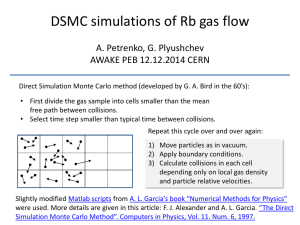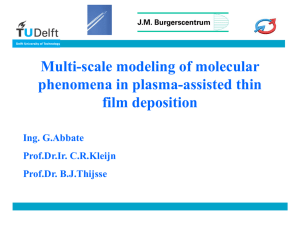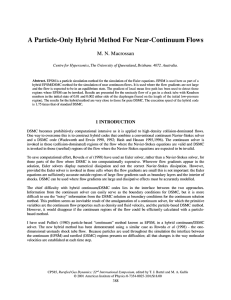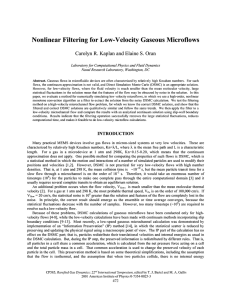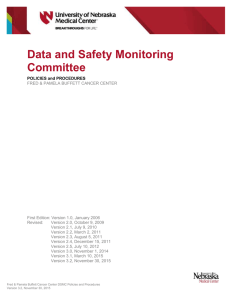Document
advertisement
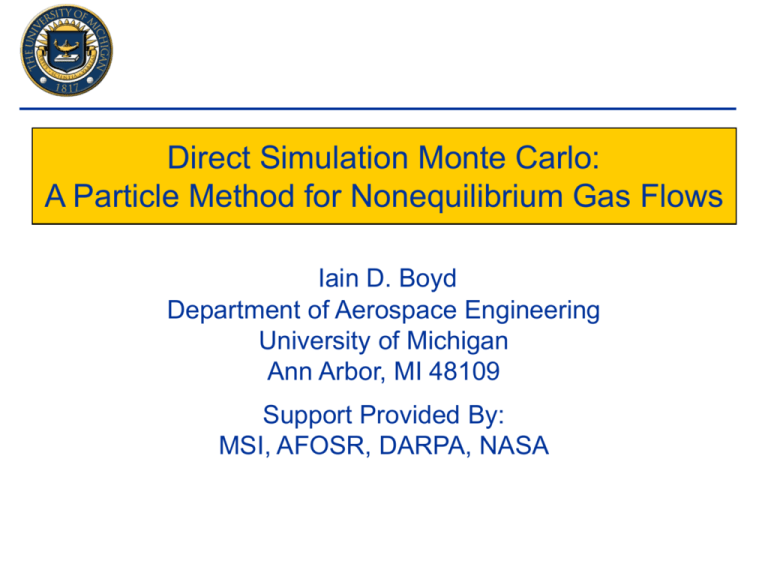
Direct Simulation Monte Carlo:
A Particle Method for Nonequilibrium Gas Flows
Iain D. Boyd
Department of Aerospace Engineering
University of Michigan
Ann Arbor, MI 48109
Support Provided By:
MSI, AFOSR, DARPA, NASA
Overview
•
Physical characteristics of nonequilibrium gas flow.
•
Direct simulation Monte Carlo (DSMC) method.
•
The MONACO DSMC code:
– data structure;
– scalar/parallel optimization.
•
Illustrative DSMC applications:
– hypersonic aerothermodynamics;
– materials processing;
– spacecraft propulsion.
•
Summary and future directions.
Modeling Considerations
•
Physical characteristics of nonequilibrium gas systems:
– low density and/or small length scales;
– high altitude hypersonics (n=1020 m-3, L=1 m);
– space propulsion (n=1018 m-3, L=1 cm);
– micro-fluidics (n=1025 m-3, L=1 m).
•
Gas dynamics:
– rarefied flow (high Knudsen number);
– collisions still important;
– continuum equations physically inaccurate.
Characterization of
Nonequilibrium Gas Flows
Flow
Regimes:
continuum
Kn
Control
equations:
slip
transitional free-molecular
0.1
0.01
10
DSMC
Boltzmann Equation
Navier-Stokes
Euler
Burnett
Collisionless
Boltzmann Eqn
Direct Simulation Monte Carlo
• Particle method for nonequilibrium gas flows:
– developed by Bird (1960’s);
– particles move/collide in physical space;
– particles possess microscopic properties,
e.g. u’ (thermal velocity);
– cell size Dx ~ l, time step Dt ~ t=1/n;
– collisions handled statistically (not MD);
– ideal for supersonic/hypersonic flows;
– may be combined with other methods
(CFD, PIC, MD) for complex systems.
{
u’, v’, w’
x, y, z
m, erot, evib
Direct Simulation Monte Carlo
The DSMC Algorithm
•
MOVE:
– translate particles Dx = u Dt;
– apply boundary conditions (walls, sources, sinks).
•
SORT:
– generate list of particles in each cell.
•
COLLIDE:
– statistically determine particles that collide in each cell;
– apply collision dynamics.
•
SAMPLE:
– update sums of various particle properties in each cell.
Current DSMC-Related Projects
•
Hypersonics:
– vehicle aerodynamics (NASA-URETI);
– hybrid particle-continuum method (AFOSR);
– TOMEX flight experiment (Aerospace Corp).
•
Space propulsion:
– NEXT ion thruster, FEEP (NASA);
– Hall thrusters (DOE, NASA);
– micro-ablation thrusters (AFOSR);
– two-phase plume flows (AFRL).
•
Micro-scale flows:
– low-speed rarefied flow (DOE).
The DSMC Code MONACO
•
MONACO: a general purpose 2D/3D DSMC code.
•
Physical models:
– Variable Soft Sphere (Koura & Matsumoto, 1992);
– rotational relaxation (Boyd, 1990);
– vibrational relaxation (Vijayakumar et al., 1999);
– chemistry (dissociation, recombination, exchange).
•
Applications:
– hypersonic vehicle aerodynamics;
– spacecraft propulsion systems;
– micro-scale gas flows, space physics;
– materials processing (deposition, etching).
MONACO: Data Structure
•
Novel DSMC data structure:
– basic unit of the algorithm is the cell;
– all data associated with a cell are stored in cache;
– particles sorted automatically.
MONACO: Scalar Optimization
•
Inexpensive cache memory system used on workstations:
– data localization leads to performance enhancement.
•
Optimization for specific processor:
– e.g. overlap *add*, *multiply* and *logical* instructions.
MONACO: Parallel Implementation
•
Grid geometry reflected in the code data structure:
– domain decomposition employed.
•
When a particle crosses a cell edge:
– particle pointed to new cell;
– thus, particles sorted-by-cell automatically.
•
When a particle crosses a domain edge:
– communication link employed;
– linked lists of particles sent as matrix;
– inter-processor communication minimized;
– no explicit synchronization required.
MONACO: Parallel Implementation
MONACO: The Software System
•
Consists of four modular libraries:
– KERN, GEOM, PHYS, UTIL.
MONACO: Code Performance
•
MONACO performance on IBM SP (Cornell, 1996):
– largest DSMC computation at the time;
– best performance with many particles/processor;
– parallel performance ~ 90%;
– serial performance 30-40%.
MONACO: Unstructured Grids
Hypersonic flow around
a planetary probe
3D Surface geometry of
TOMEX flight experiment
DSMC Applications:
1. Hypersonic Aerothermodynamics
• Hypersonic vehicles encounter a variety of flow regimes:
- flights/experiments are difficult and expensive;
- continuum: modeled accurately and efficiently using CFD;
- rarefied: modeled accurately and efficiently using DSMC.
NASA’s Hyper-X
DSMC: particle approach
high altitude
sharp edges
uses kinetic theory
CFD:
continuum approach
low altitude
long length scales
solves NS equations
Hypersonic Viscous Interaction
•
Flow separation configuration:
– N2 at M~10 over double cone;
– data from LENS (Holden).
Shock-Shock Interactions
•
Cowl lip configuration:
– N2 at M~14;
– data from LENS (Holden).
Complex 3D Flows
•
TRIO flight experiment:
– analysis of pressure gauges;
– external/internal flows.
Aerothermodynamics
Of Sharp Leading Edges
• Computations of hypersonic flow around several
power-law leading edge configurations performed
using MONACO at high altitude.
• Advanced physical modeling:
- vibrational relaxation and air chemistry;
- incomplete wall accommodation.
• Effects of sharpening the leading edge:
- reductions in overall drag coefficient and shock
standoff distance;
- increases in peak heat transfer coefficient.
Flow Fields
Temperature Ratio (T / T∞)
Cylinder at 7.5 km/s
n=0.7 at 7.5 km/s
Aerothermodynamic Assessment
Drag Coefficient
Shock Standoff Distance/
Heat Transfer Coefficient
DSMC Applications:
2. Materials Processing
3M experimental chamber for YBCO deposition
Top
view
Side
view
• Effect of atomic collisions:
– between the same species;
– between different species.
3D MONACO Modeling
•
20x60x50 cuboid cells.
•
Non-uniform cell sizes.
•
2,000,000 particles.
•
Overnight solution time
Yttrium Evaporation
Source flux: 9.95x10-5 moles/sec
Number density
Z-component of velocity
Yttrium Evaporation
• Comparison of calculated and measured film
deposition thickness.
• Significant effect of atomic collisions.
Yttrium Evaporation
Calculated and measured atomic absorption spectra:
– along an aperture close to the substrate symmetry line;
– at frequencies of 668 nm (left) and 679 nm (right).
Co-evaporation of Yt, Ba, and Cu
Source fluxes (10-5 moles/cm2/sec)
Y : Ba :Cu = 0.84 : 1.68 : 2.52
Total Number Density
Co-evaporation of Yt, Ba, and Cu
Flux (moles/cm2/s) across the substrate
Yt
Ba
Cu
DSMC Applications:
3. Spacecraft Propulsion
•
Tasks for spacecraft propulsion systems:
– orbit transfer (e.g. planetary exploration);
– orbit maintenance (e.g. station-keeping);
– attitude control.
•
Motivations for development of accurate models:
– simulations less expensive than testing;
– improve our understanding of existing systems;
– optimize engine performance and lifetime;
– assessment of spacecraft integration concerns.
Spacecraft Propulsion
Arcjet
(Stanford)
Hall:stationary
plasma thruster
(SPT-100)
Gridded
ion thruster
(UK-10)
Pulsed
Plasma
Thruster
(EOS-1)
Express Spacecraft
•
Two Russian GEO spacecraft launched in 2000:
– SPT-100 Hall thrusters used for station-keeping;
– in-flight characterization program managed by NASA;
– first in-flight plume data for Hall thrusters.
•
Diagnostics employed on spacecraft:
– electric field sensors;
– Faraday probes (ion current density);
– retarding potential analyzers, RPA’s (ion current
density, ion energy distribution function);
– pressure sensors;
– disturbance torques (from telemetry data).
Express Spacecraft
Particle In Cell (PIC)
•
Particle method for nonequilibrium plasma:
– developed since the 1960’s;
– charged particles move in physical
E4
space;
– particles possess microscopic
properties, e.g. u’ (thermal velocity);
– cell size Dx ~ d, time step Dt ~ 1/w;
E1
– self-consistent electric fields, E;
– may be combined with DSMC for
collisional plasmas.
E3
E2
{
u’, v’, w’
x, y, z
m, q
Hybrid DSMC-PIC
•
Particle model for ions, fluid model for electrons.
•
Boltzmann relation for electrons provides potential:
– currentless, isothermal, un-magnetized, collisionless;
– quasi-neutrality provides potential from ion density:
kT n
*
ln
n *
e
•
Collision mechanisms:
– charge exchange;
– momentum exchange.
Number Densities (m-3)
Xe+ ion
Xe atom
Ion Current Density
Ion Energy Distributions
Beam plasma (15 deg.)
CEX plasma (77 deg.)
Summary
•
Direct simulation Monte Carlo:
– now a mature, well-established technique;
– statistical simulation of particle dynamics;
– applied in many areas of engineering/physics;
– use growing due to improved computer power.
•
Some advantages of DSMC:
– accurate simulation of nonequilibrium gas;
– framework for detailed physical modeling;
– can handle geometric complexity;
– can be combined with other methods for multiscale and multi-process systems.
Future Directions
•
Development of MONACO:
– unsteady and 3D flows;
– user help: “DSMC for dummies”;
– dynamic domain decomposition;
– more detailed physical models.
•
Extensions of DSMC:
– hybrid DSMC-CFD (using IP interface);
– generalized hybrid DSMC-PIC;
– 2-phase DSMC (gas and solid particles);
– speedup: implicit DSMC, variance reduction.
